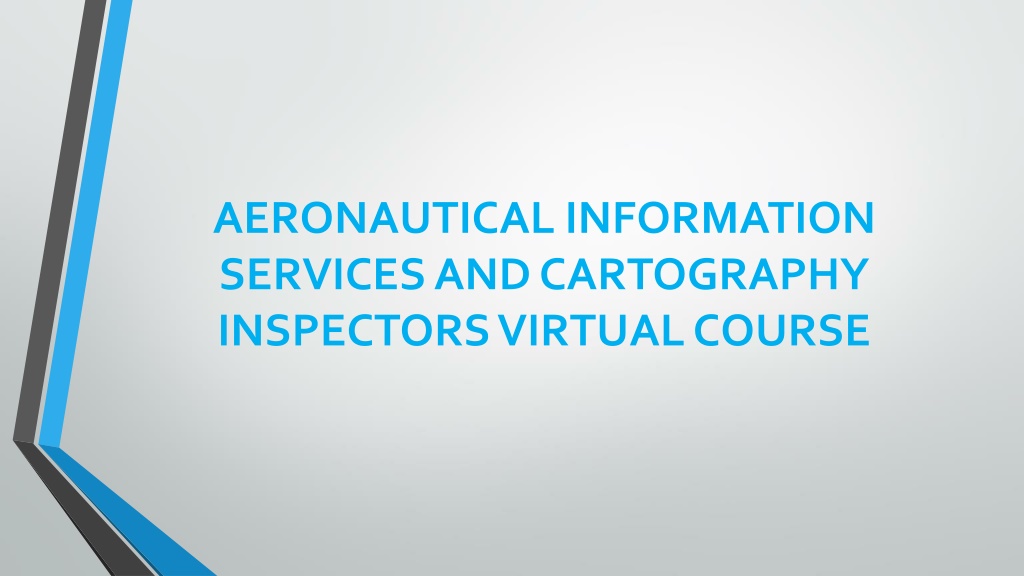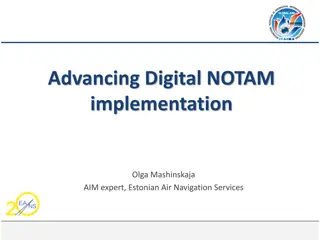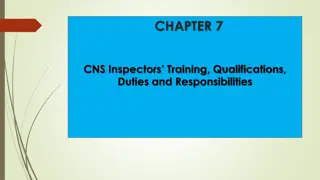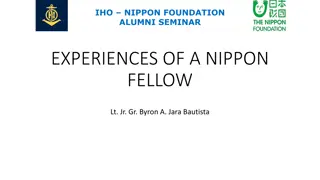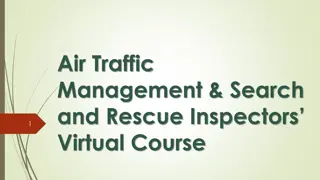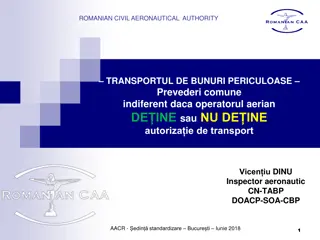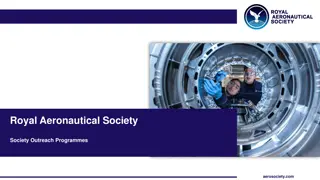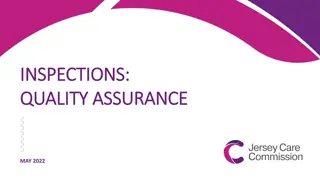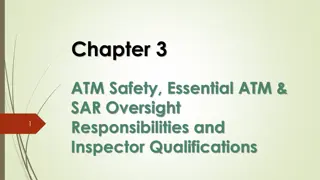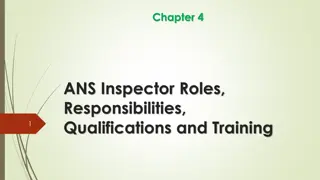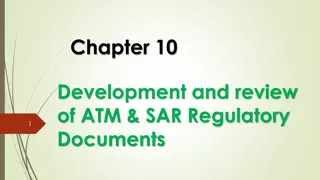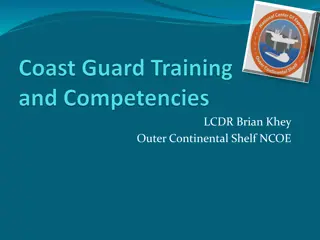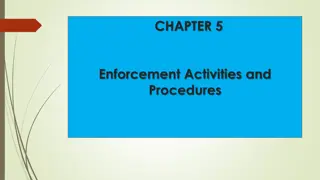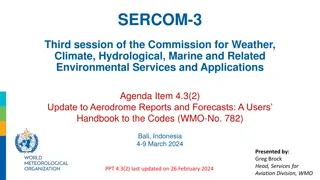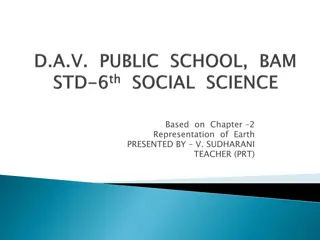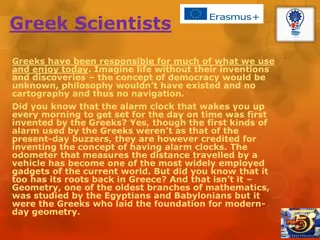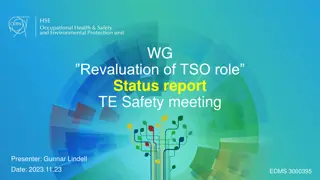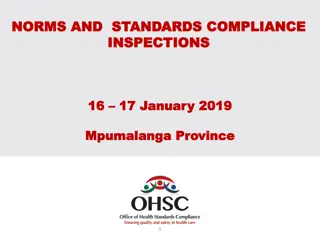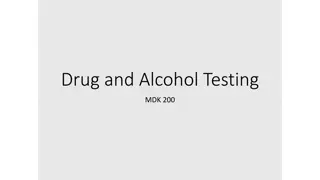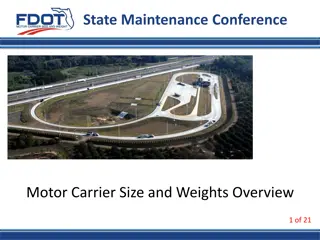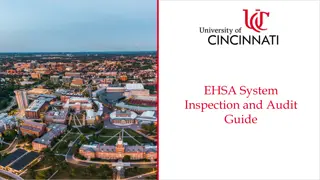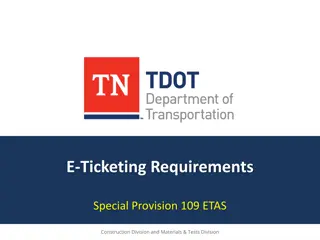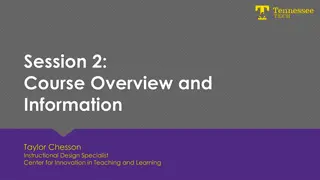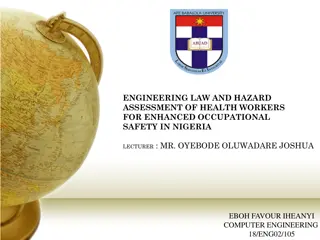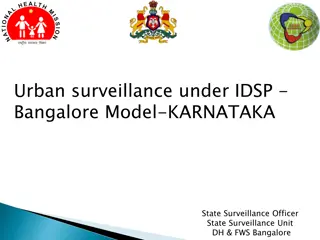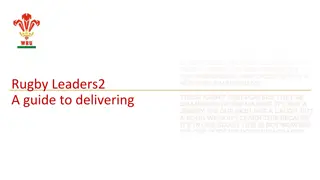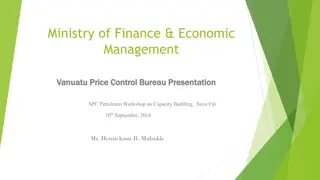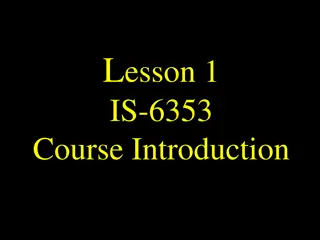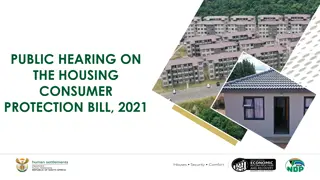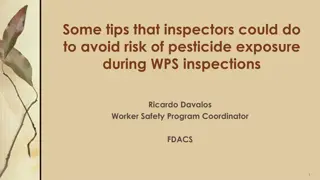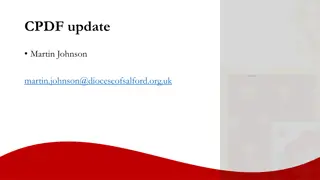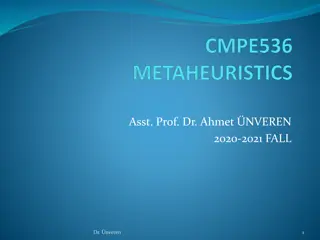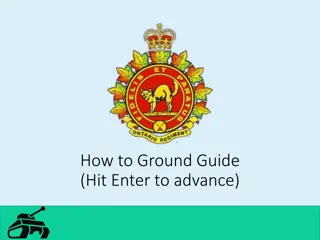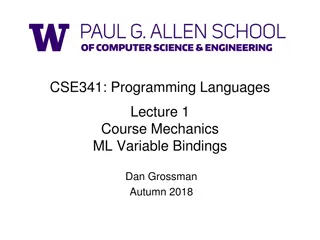Aeronautical Information Services and Cartography Inspectors Course Overview
This virtual course provides comprehensive training on aviation safety oversight, focusing on the roles and responsibilities of Aeronautical Information Services (AIS) and Cartography Inspectors. Participants will learn about regulatory frameworks, audit processes, competency assessment, and enforcement of standards. By the end of the course, learners will be equipped to effectively conduct safety oversight activities in the field of AIS and Cartography.
Download Presentation

Please find below an Image/Link to download the presentation.
The content on the website is provided AS IS for your information and personal use only. It may not be sold, licensed, or shared on other websites without obtaining consent from the author. Download presentation by click this link. If you encounter any issues during the download, it is possible that the publisher has removed the file from their server.
E N D
Presentation Transcript
AERONAUTICAL INFORMATION SERVICES AND CARTOGRAPHY INSPECTORS VIRTUAL COURSE
CHAPTER TWO The AIS and Cartography Safety Oversight
COURSE CONTENT Aviation Safety Oversight and the USOAP-CMA; The AIS and Cartography Safety Oversight Development and Review Regulations and other Oversight Documentation Tools used in AIS and Cartography oversight Audit/Inspection of an AIS and Cartography Providers Post-Audit Activities and audit/inspection Outcomes AIS and Cartography Competency Assessment and Certification (CE - 6) Continuous Surveillance of an AIS and Cartography provider (CE -7) Resolution of AIS and Cartography safety issues (CE -8) Enforcement of AIS and Cartography Related Standards and Regulations (CE -8)
COURSE OBJECTIVES At the end of this course the participant should be able to: Describe the ICAO Safety Oversight function and the USOAP/CMA; Demonstrate an understanding of the State Safety Oversight including the AIS and Cartography Inspector Roles within the Oversight organization Understand the duties and responsibilities an AIS and Cartography Inspector; Develop and Review Regulations, Guidance Material and other oversight documentation Develop and effectively utilize the tools used for the oversight of AIS and Cartography Service Providers; Conduct an Audit of an AIS and Cartography Service provider; Write and disseminate an audit report and undertake follow-up activities; Be able to undertake Resolution of safety issues and enforcement actions
Introduction The aviation safety inspector is a qualified person authorized by the State to carry out safety oversight activities for civil aviation (Doc 10070). On the other hand Safety oversight is a function performed by a State to ensure that individuals and organizations performing an aviation activity comply with safety-related national laws and regulations (Doc 9734) . Consequently for one to undertake the roles of an AIS or Cartography Inspector he/she has to be qualified and be authorized to undertake the function. To effectively fulfil its oversight responsibilities, a State civil aviation system needs to be: properly organized, and; staffed with qualified personnel capable of accomplishing the required wide range of technical duties involved in safety oversight. 5
Introduction The CAA must establish favourable conditions for the inspector to be able to work or execute the required tasks Requires delegation of specific powers of authority to Inspectors to support the accomplishment of their tasks. This form of arrangement needs to be contained in the primary aviation law It is also necessary that States create favorable conditions that allow oversight inspectors and auditors to discharge their duties. These include: Establishment of clear and comprehensive workplace policies and procedures; Provision of a safe working environment; and Supplying inspectors and auditors with adequate workplace resources. 6
Introduction AIS and Cartography Inspectors Qualification Criteria; States define qualification criteria for their auditors/inspectors so as to ensure an appropriate level of knowledge, training, experience and competency, covering at minimum, the following aspects: knowledge and understanding of the requirements against which audits and inspections are to be performed; techniques of examining, observing, interviewing, evaluating and reporting; skills required for managing an audit/ inspection such as planning, organizing, communicating, documenting and directing competency of auditors/inspectors that should be evaluated on a regular basis. 7
Introduction AIS and Cartography Inspectors Qualification Criteria; Since the inspector will be responsible for implementing the audit/inspection programme, s/he should have the necessary competence to do so; Should be able to take care of the associated risks and opportunities and external and internal issues effectively and efficiently, including knowledge of: a) audit principles methods and processes; b) applicable regulations ,standards and reference/guidance documents; c) information regarding the auditee and its context (e.g. external/internal issues, relevant interested parties and their needs and expectations, business activities, products, services and processes of the auditee); d) applicable statutory and regulatory requirements and other requirements relevant to the business activities of the auditee. 8
Inspector Qualification Requirements The auditors/inspectors should be knowledgeable on audit principles, procedures and methods; Be able to comprehend the audit scope and apply audit criteria depending the area of inspection; Application of the audit criteria will allow verification of compliance and a point of reference against which the audit evidence is compared; The auditors/inspectors should be aware of the legal, regulatory and policies of the organization and be able to work within the framework. . 9
Inspector Qualification Requirements AIS & Cartography Auditors/inspectors should have: a) achieved (academic) that is stipulated by the organization for the position held; competency through formal education b) Have undertaken specific professional training; c) Accumulated relevant technical experience commensurate to the function that is being oversighted (5 years ++); d) Undergone requisite OJT as an inspector with an experienced officer who will in turn certify that he has attained the desired audit experience. 10
Inspector Qualification Requirements The CAA should establish and control the competencies of its AIS and Cartography inspectors. it should provide training or take other actions to reach the established level of competency, and it should evaluate the effectiveness of these actions. The CAA should ensure that safety inspectors are competent to carry out the tasks assigned to them; and that they are aware of the consequence of their actions for aviation safety. 11
Inspector Qualification Requirements For the officers who are joining the inspectorate the following qualifications may be mandatory. However, this may vary from state to state. a) a broad air navigation service background of five years or more; b) experience in aeronautical information service and cartography c) experience in technical training, on job training and use of various systems and applications deployed by the service provider d) a reputation for possessing qualities of initiative, tact, tolerance and patience; and e) training in auditing techniques. 12
Roles of an AIS Oversight Organization The AIS oversight organization is meant to support State in achieving its oversight mandate. It s key roles include: a) Facilitate the recruitment of adequate and competent inspectorate personnel (apply a methodology to determine the staffing needs) b) Facilitate continuous training of the inspectorate team; c) Establishing State safety standards and approving AISP Quality Management Systems documentation; d) Monitoring compliance with safety standards and QMS through routinely and objectively auditing and inspecting the AISP; e) Development and review of the legislation and regulations for the oversight function; 13
Roles of an AIS Oversight Organization The AIS oversight organization is meant to support State in achieving its oversight mandate. It s key roles include .continued: f) Putting systems in place to facilitate competency assessment of the AIS personnel (as may be applicable); g) Monitoring the AIS & Cartography Service providers corrective actions and continuous ensure service delivery improvement; h) Providing On-job training to AIS and Cartography Oversight technical personnel; i) Certificating AISPs (where provided in law). 14
Inspector Duties and responsibilities The AIS and Cartography tasks are not static but dynamic in nature; Inspectors duties have to adapt to the changing regulatory environment and the specific needs of their oversight organization. Have to adapt the priciples and guidelines provided by ICAO The principal operational duties of inspectors will normally be focused on inspection, certification and on-going surveillance. 15
Duties of an AIS/Cartography Inspector Development and review of regulations Development and review of technical guidance material Undertake / conduct of audits and inspections, generation of reports and making associated follow-ups for compliance Oversight of AIS and Cartography functions , including the QMS; Tracking the ICAO State letters and providing applicable responses as per the state work flow; Review and recommending for approval the ANSP operations manual, QMS manual training programme and plan and recommending the same for approval; Review of the aeronautical products for approval purposes Review of IFPs (where the role is assigned) and recommending the same for approval Management of various records 16
Duties and responsibilities of AIS Inspectors 1. Certification of the ANSP (where applicable) ICAO Doc 9734 Part A para 3.6.3.5 states that Although some States require the certification of ANS providers, such certification is not mandatory according to ICAO provisions; Where the above obtains in a particular state then the role of the inspector shall be to ensure that the service providers effectively comply with the safety-related national legislation. 17
Duties and responsibilities of AIS Inspectors 1. Certification of the ANSP (where applicable) In circumstances where an authorization is given to provide any of the ANS services ( including AIS and Cartography) then the following aspects apply:- The purpose of issuing a certificate is to certify that a specified ANSP/AISP operations are authorized by the State and are to be conducted in compliance with applicable regulations and rules. The CAA will need to establish procedures for the issuance of the certificate and for the continuing safety oversight and inspection. The Inspector will have to participate in the five phase certification process that includes pre-application phase, formal application phase, document evaluation phase, demonstration and inspection phase and the certification phase. 18
Duties and responsibilities of AIS Inspectors 2. Surveillance Monitor the performance of the AIS and Cartography Services provider to ensure compliance with promulgated regulations and standards; Undertake regular audits/inspections to ensure compliance in the provision of AIS and Cartography Services including the implementation of quality management system; Where implemented ensure all personnel involved in the provision of services have the necessary competency in accordance with applicable regulations; Review AISPs Manuals of operations or other relevant documents and recommend for approval or amendments thereto; 19
Duties and responsibilities of AIS Inspectors 3. Surveillance Cont. Evaluate AIS and Cartography training programmes to ensure that training provided addresses the ability of staff to provide the required services for the safety, regularity and efficiency of air navigation; Ensure that the service provider develops and implements periodic training plans that are anchored on the training programme; Where applicable evaluate and recommend for approval flight procedures subject to the state work flow. Confirm if the AISP has published the mandatory charts 20
Duties and responsibilities of AIS Inspectors 3. Surveillance Cont. Annex 4 contains the specifications for seventeen types of aeronautical charts for which an international need for uniformity has been established. Of these charts the production/availability of six types of charts is mandatory, six non-mandatory and for four types of charts the production is conditional . The six mandatory charts are the Aerodrome Obstacle Chart ICAO Type A; Precision Approach Terrain Chart ICAO; Enroute Chart ICAO; Instrument Approach Chart ICAO; Aerodrome/Heliport Chart ICAO; and the World Aeronautical Chart ICAO, 1:1 000 000. 21
Duties and responsibilities of AIS Inspectors 4. Resolution of Safety Issues. ensure that identified safety issues are resolved in a timely manner; Provide deadlines for the submission of the corrective action plan to be taken by the service provider; Verify that corrective actions and related timeframes are appropriate, before formal acceptance of the corrective action plan. Initiate appropriate follow-up to verify the effective implementation of the corrective actions ( Develop a tracking system for the recording and following up resolution of identified non-compliances) 22
Duties and responsibilities of AIS Inspectors 5. Regulation Transpose ICAO standards into State specific legislation and regulations; Develop/review guidance material as may be necessary to facilitate the implementation of the regulations and standards; Recommend enforcement action in areas of non-compliance. Review existing legislation/regulations and recommend amendments thereto; Evaluate ANSP applications and recommend for certification; Analyse ICAO State letters and recommend appropriate action. Undertake the approval of aeronautical products 23
AIS Inspector Training and Competencies a robust training system needs to be established and implemented by the State to ensure that technical personnel receive the required training in an effective manner and maintain their competency,. The required comprehensive training is meant to ensure that they are adequately qualified to perform their regulatory functions and duties. Acquisition of this knowledge is acquired through a combination of: a) formal training courses; and b) on-the-job training. 24
AIS Inspector Training and Competencies The concerned state ought to develop and implement a policy established and signed at the management level; The training policy should commit to provide all necessary training to the AIS and Cartography Inspector in all areas, including initial training (e.g. induction and basic training), on- the-job training (OJT), recurrent training and specialized or advanced training; The training should be tailored to enable them execute they day to day tasks; Necessary funding should also be provided to support the training of the inspectors. 25
AIS Inspector Training and Competencies The training policy should provide for development of a Training programme for the AIS and Cartography Inspectors so as to meet the requirements of CE 4 of an effective safety oversight system. In the training programme, subjects of regulatory functions and specialized areas should be developed in order to provide overall skill and knowledge to the inspectors so as to meet the intent of the following objectives:- Instilling knowledge and ethics regarding the overall functioning of the oversight organization and the regulatory framework. Familiarizing the inspectors with knowledge, procedures and practices required at various level of functioning. Standardizing the knowledge and understanding of inspectors. 26
AIS Inspector Training and Competencies Enabling the inspectors to take various decisions in their area of work. Empowering the safety inspectors with international best practices followed by other regulatory authorities. Providing guidance for technical documentation and record keeping. Orientating the inspectors towards their functioning in their specific oversight area. Optimizing resources and management of work. Developing skill and confidence through a structured On-Job Training (OJT) so as to enable the inspectors work independently and in teams. Improving the overall personality of inspectors. 27
AIS Inspector Training and Competencies a periodic training plan should be developed based on the training programme established for the staff member s position. The training plan should detail the type of training to be provided during a specified timeframe as well as the training priorities. An AIS & Cartography Inspector shall only be authorized to perform safety oversight duties in the area or subject where the staff member has satisfactorily completed the required training and maintains the required competence. it is essential that the inspectors are also provided with training on subjects such as applicable CAA regulations, inspectors skills, knowledge, duties and responsibilities, and CAA procedures for the implementation and enforcement of requirements 28
AIS Inspector Training and Competencies 1.Initial training The basic component of initial training should address the following topics: departmental ethics/conduct and discipline; security aspects of the safety inspector s work; the role of safety oversight inspectors, their codified level of authority and degree of responsibility; overview of CAA-regulated entities and associated challenges; basics of human factors; 29
AIS Inspector Training and Competencies 1. Basic components of initial training Cont. certification and authorization policies, processes and procedures; surveillance and inspection policies, processes and procedures; audit policies, processes, and procedures; investigations and enforcement policies, processes and procedures; risk assessments; State safety programme (SSP); safety management systems (SMS); Quality Management Systems 30
AIS Inspector Training and Competencies 2. Specialized Training The purpose of specialized training is to upgrade the knowledge and competency of inspectors to be at par with international standards and for efficient functioning. During specialization training, Safety inspector candidates apply the knowledge and skills acquired during the basic phase. Often this can best be accomplished by introducing realistic, but hypothetical, scenario-based exercises. 31
AIS Inspector Training and Competencies 2. Specialized Training Cont. Specialized training should be tailored in inspectors undertaking specific tasks related to the day to day activities like:- Review for approval of service provider operation manuals Review for acceptance training programmes and plans Conduct of inspections conduct a realistic risk assessment; assess a Quality Assurance programme; Note: During specialization training, the instructor should assess if the trainees demonstrate all the competencies at the level determined by the CAA. 32
Additional Training for Inspectors 3. Recurrent training This type of training is necessary to ensure that inspectors maintain competency, proficiency and keep current on latest techniques, procedures and new developments in their respective areas of expertise. Allows inspectors effectively respond to the needs of the industry, particularly when rapid improvements in technology and methodologies arise, while making sure that they are effective in their safety oversight duties covers additional specialized topics/changes/improvements within the industry relevant to the inspector s assigned area of responsibility. 33
AIS Inspector Training and Competencies 4. Requalification Training The CAA must establish policies regarding the maintenance of inspector competencies and qualifications. Policy addresses extended periods of absence from the inspectorate or from performing a specific function (e.g. audits or qualification checks) along with the re-training requirements to achieve and maintain the competencies to the level required. important for those individuals who represent the temporary workforce that is brought in under service agreements. 34
AIS Inspector Training and Competencies 5. Advanced Training The goal of advanced training is to enhance the competencies of experienced inspectors so they can effectively address challenging and complex oversight issues. These are competencies essential to effectively supervise the delivery of oversight programmes or lead multi-disciplinary inspection teams, including in performance-based regulatory environments. Training in the following areas can support the acquisition of competencies that inspectors should demonstrate as senior inspectors: 35
AIS Inspector Training and Competencies 5. Advanced Training Training in the following areas can support the acquisition of competencies that the inspector should demonstrate: a) programme management; b) organizational cultures and change management; c) quality management system implementation and audit techniques; d) dispute resolution; e) root cause analysis; f) corrective and preventive action plans; and g) conducting investigations and enforcement procedures 36
AIS Inspector Training and Competencies 6. On-job Training Technical personnel should satisfactorily complete OJT before being assigned safety oversight-related tasks and responsibilities. The OJT should : a) be provided by experienced, senior inspector as appropriate; and, b) follow a structured program that includes observing as the qualified inspector carries out oversight activities, working under supervision, competence assessment and authorization, etc. 37
AIS Inspector Training and Competencies 6. On-job Training Cont. The potential inspector must, a) participate in the number of inspections specified in the training program while observing a qualified ANS Inspector conduct the audits; and, b) personally conduct the number of inspections specified in the training program under the supervision of an experienced/qualified ANS Inspector. 38
Continued Inspector Qualifications After completion of on-the job training, the AIS & Cartography Inspector will be issued with an authorization to undertake or perform inspections, investigations and audits on the service provider. The following courses may be relevant for the continued competence of the inspector. Air Navigation Services (AIS Inspectors Course) Compliance and enforcement procedures course Regulatory Auditing Techniques SSP/SMS Course AIS Data Quality Management Aeronautical Charts refresher Quality management Systems Safety Oversight Auditor s Course Documentation, Record keeping and Report Writing Training Instructors Course USOAP CMA CBT (ANS) Basic and Advanced AIXM Surveillance Course 39
AIS Inspectors Attributes/Behaviours Inspectors should possess the necessary attributes to enable them to act in accordance with the principles of auditing. should exhibit professional behaviours during the performance of audit activities. Desired professional behaviours include being: a) ethical, i.e. fair, truthful, sincere, honest and discreet; b) open-minded, i.e. willing to consider alternative ideas or points of view; c) diplomatic, i.e. tactful in dealing with individuals; d) observant, i.e. actively observing physical surroundings and activities; e) perceptive, i.e. aware of and able to understand situations; 40 f) versatile, i.e. able to readily adapt to different situations;
AIS Inspectors Attributes/Behaviours Desired professional behaviours .continued: g) tenacious, i.e. persistent and focused on achieving objectives; h) decisive, i.e. able to reach timely conclusions based on logical reasoning and analysis; i) self-reliant, i.e. able to act and function independently while interacting effectively with others; j) able to act with fortitude, i.e. able to act responsibly and ethically, even though these actions may not always be popular and may sometimes result in disagreement or confrontation; k) open to improvement, i.e. willing to learn from situations; l) culturally sensitive, i.e. observant and respectful to the culture of the auditee; m) collaborative, i.e. effectively interacting with others, including audit team members and the auditee s personnel. 41
AIS Inspectors Knowledge and Skills Inspectors should possess the knowledge and skills necessary to achieve the intended results of the audits/inspections that they are expected to perform. An auditor should be able to: a) understand the types of risks and opportunities associated with auditing and the principles of the risk-based approach to auditing; b) plan and organize the work effectively; c) perform the audit within the agreed time schedule; d) prioritize and focus on matters of significance; e) communicate effectively, orally and in writing (either personally, or through the use of interpreters); f) collect information through effective interviewing, listening, observing and reviewing documented information, including records and data; 42
AIS Inspectors Knowledge and Skills An auditor should be able to .. continued: g) understand the appropriateness and consequences of using sampling techniques for auditing; h) understand and consider technical experts opinions; i) audit a process from start to finish; j) verify the relevance and accuracy of collected information; k) confirm the sufficiency and appropriateness of audit evidence to support audit findings and conclusions; l) assess those factors that may affect the reliability of the audit findings and conclusions; m) document audit activities and audit findings, and prepare reports; 43 n) maintain the confidentiality and security of information accessed.
Inspector Competencies The oversight inspector competencies are used to reliably predict successful performance of inspectors in the performance of their duties and tasks. This is especially useful as inspectors need to adapt to a changing regulatory environment. Over the course of their careers, inspectors will find themselves in unusual and frequently complex situations. Depending upon the circumstances, they can be called upon to act as observers, analysts, investigators, auditors, mediators, negotiators, technical experts, judges or even as witnesses. Technical expertise alone does not prepare a person to function competently in such an environment. 44
The ICAO Inspector Competency Framework For these reasons, ICAO Promotes a competency framework for safety oversight inspectors. The ICAO competency frameworks present a set of competencies for a given aviation discipline. Each competency has an associated description and observable behaviours. It is a generic blueprint to guide the development and maintenance of a strong inspectorate workforce. The ICAO Civil Aviation Safety Inspectors competency framework should be adapted by States to the context of the oversight organization in which the inspectors work. 45 .
INSPECTORS AND THE FUTURE Conclusively Implementing competency-based training and assessment can yield the following benefits: a) It ensures that inspector s achieve a level of performance that enables them to work independently and effectively. b) It supports decision-makers/managers in monitoring the ongoing competence of inspectors through the identification and collection of assessment evidence. c) It supports the early identification of performance gaps and the design of more effective training to close the performance gap. d) It supports the development of effective recruitment and selection tools. e) It supports a more accurate analysis of how the inspector tasks, techniques and methods will be affected by changes which, in turn, will support the development of more effective continuation training. 46
Inspector Credentials Issuance all technical personnel authorized to perform licensing, certification, approval and/or surveillance functions, as applicable, need to possess appropriate credentials (with the empowering legislation indicated)- (ICAODoc 9734 para. 3.3.2.2); The credential identifies the inspectors as technical experts employed by the CAA, with the right to unlimited and unrestricted access to aircraft, aviation-related documents, aerodromes, ANS and other relevant facilities and the associated inspection powers, as applicable and as provided by the primary legislation. They also need to be provided with guidance that addresses ethics, personal conduct and the avoidance of actual or perceived conflicts of interest in the performance of official duties Use of Credentials a) The credentials shall be used only in the conduct of official business b) Holders of credentials are responsible for their proper safekeeping at all times 47 c) Misuse or improper possession of the credentials can subject the offender to disciplinary action.
Safety Management System 48
Safety Management System Introduction:- Safety management system is a systematic approach to managing safety, including the necessary accountability, responsibilities, policies and procedures. organizational structures, Safety management seeks to proactively mitigate safety risks before they result in aviation accidents and incidents. Helps States to manage their safety activities in a more disciplined, integrative and focused manner 49
Safety Management System Benefits of Safety Management a) Strengthened safety culture When management actively endorses safety as a priority, it is typically well-received by personnel and becomes part of normal operations. b) Documented, process-based approach to assure safety the documentation can be understood by all allows controlled changes when continuously improving the safety programme/system. c) Better understanding of safety-related interfaces and relationships can benefit the organization s understanding of the interprocess relationships, leading to an enhanced understanding of the end-to- end process and exposing opportunities for increased efficiencies. 50
